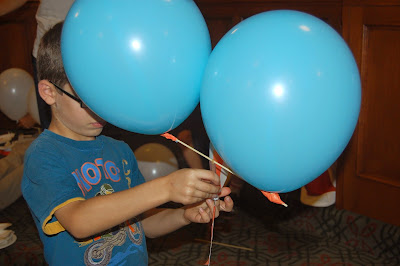Computer Science for Good: AI Lesson
Yesterday, to celebrate Computer Science Education Week, we focused on learning about one of the newest trends in computer science: machine learning artificial intelligence. We discussed how artificial intelligence can help humanity and the Earth, by making it easier to operate prosthetics, create tools for assisting people with disabilities, identify diseases and tackle environmental issues. But it can also be used for harm, such as to trick people into believing they are talking to a real person when they are not, or to trick people into believing they are watching a famous person say something they never really said. And this is just the start. That's why it's so important to learn how artificial intelligence works, so that we can harness its power for good and ethical purposes.
Code.org has a site offering resources about Computer Science for Good, and yesterday we tried out their cool AI for Oceans activity. This activity teaches kids how machine learning computers (AI) need lots of data in order to look for patterns and draw conclusions. Kids practice "teaching" the robot what is or isn't a fish in order to clean up the ocean of trash. But there are challenges. You start to see that the robot is eliminating other sea animals, so kids have to teach it what belongs in the water and what doesn't. Then kids try to teach it to distinguish between different types of fish. And finally, kids are asked to teach the robot to favor fish that embody a certain personality trait to them. This demonstrates to the child that the robot only discriminates based on the bias that is put into it. If you program the robot to favor only smiley fishes, it will eliminate frowning fishes that still have just as much right to live in the water!
Just as we don't want to be unfair to certain kinds of fish, we don't want AI to be unfair to certain kinds of people in our society. And yet we see AI show implicit bias, sexism and racism toward people when processing loan applications, school applications, job applications and even efforts to predict crime. That's why it's important that kids learn how bias infects these systems and how to stop it by supplying tons of unbiased data.
After we finished that activity, we moved on to a Scratch activity. I showed the kids a Scratch project I had programmed:
In my project an underwater robot is trying to eliminate all objects of a certain shade of bright yellow, which its program tells it are plastic. This successfully eliminates some ocean trash, but it also eliminates many fish. I challenged the kids to see if they could program the fish to move faster, or program the robot to recognize more colors of plastic trash. They could also program the robot to respond to user commands, so that it doesn't move automatically toward vulnerable fish but rather moves when the user tells it to.
I think we learned some really important things about how AI works as well as editing and modifying some Scratch code which is an important step in learning how coding works!




Comments
Post a Comment